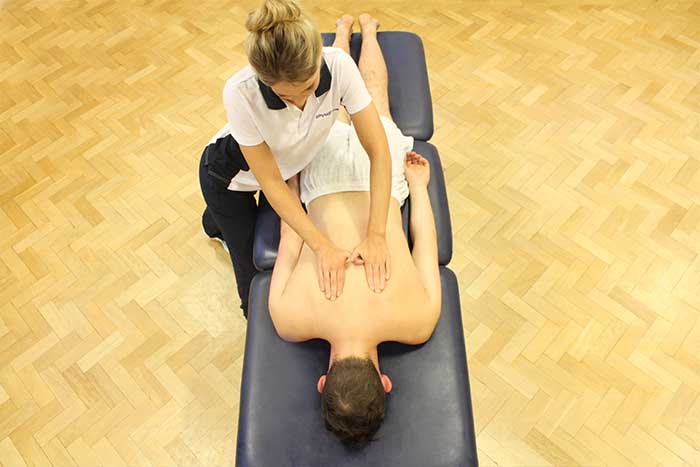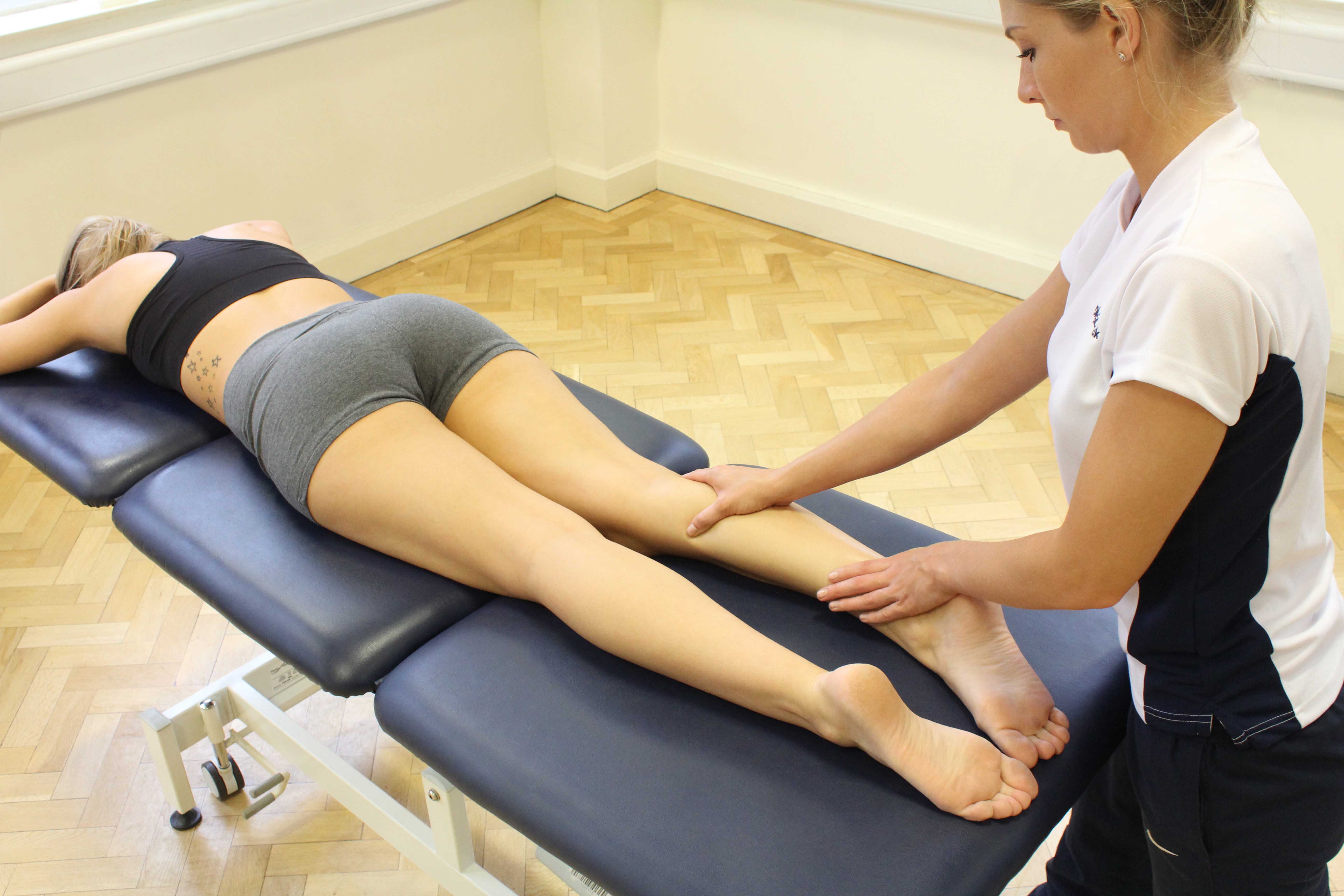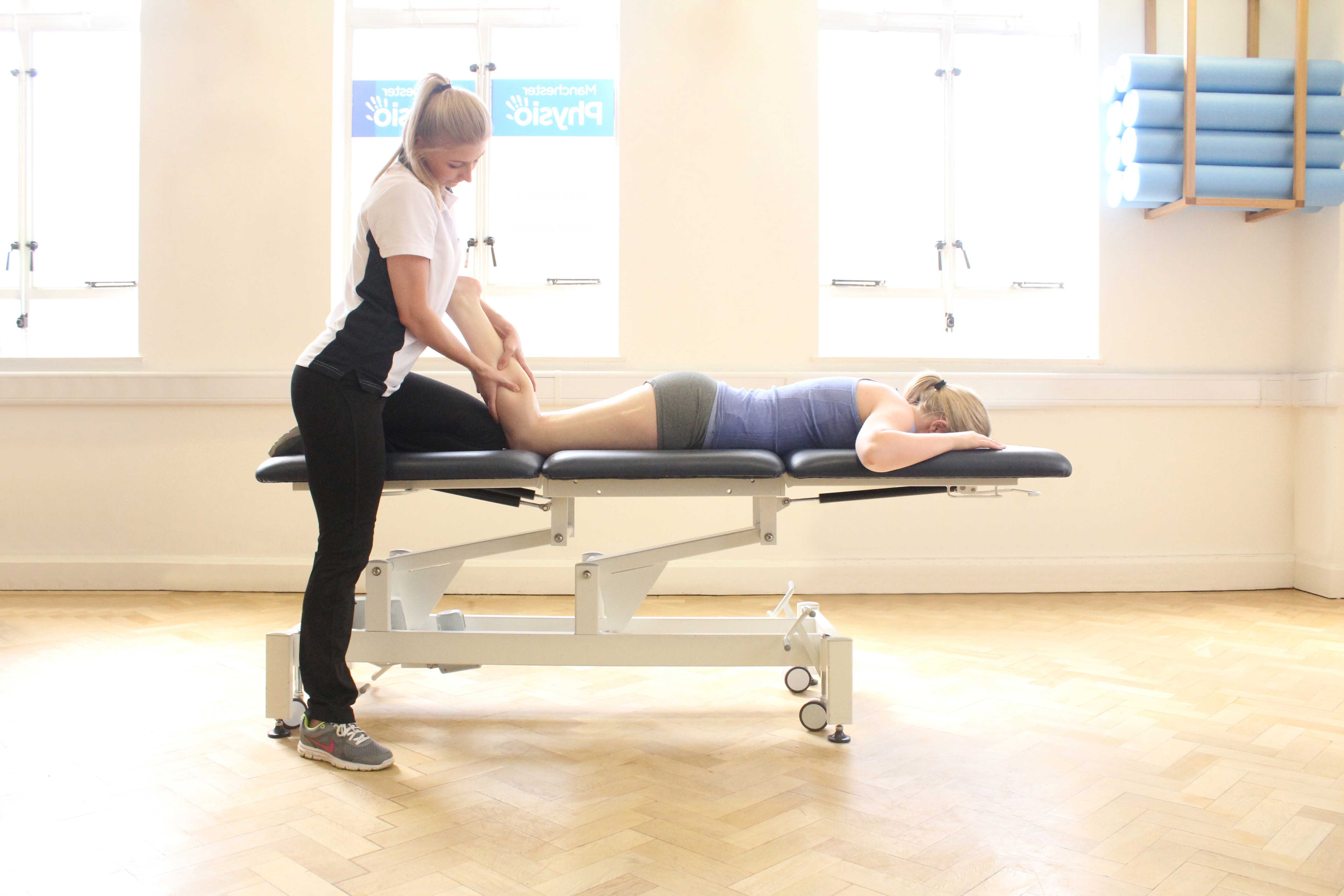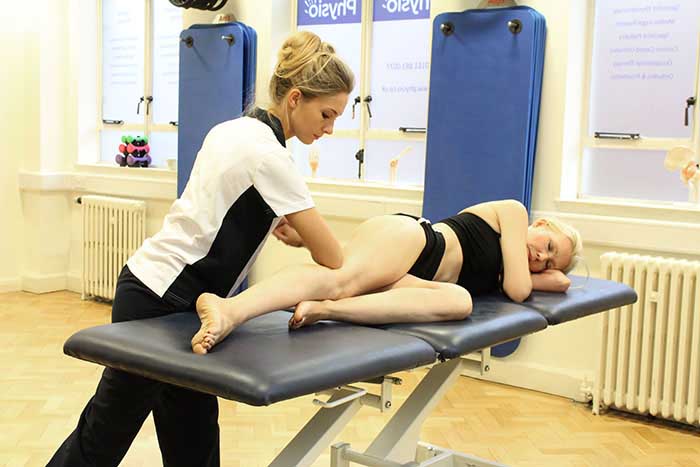What is a sports massage?
Sports massage is a deep form of soft tissue mobilisation. A sports massage can be applied in a sporting and non-sporting context. Sports massage involves a wide range of techniques that include effleurage, kneading, wringing, hacking and trigger pointing. A sports massage is used for general relaxation of the muscular skeletal system as well as being directed towards any problem areas. Sports massage helps relieve muscular tension, break down adhesion's, mobilise soft tissues and reduce pain.
Who should be treated?
Sports massages are not limited to athletes. Sports massage is an appropriate massage treatment for anyone who is in need of a remedial or soft tissue mobilisation. The remedial effects of sports massage are beneficial post-surgery, alongside physiotherapy, osteopathy or chiropractic, or as a health benefit within an office environment.
Within a sporting context, people who participate in sport can use a sports massage as a regular part of their training programme. Sports massage is also effective as a performance enhancement. Although the name implies a sporting clientele, it is a massage treatment appropriate to all.

What techniques are used in a sports massage?
At Physio.co.uk our massage therapists are experienced with a wide range of massage techniques. Common massage techniques used during a sports massage include:
 Above: Sports massage focused on latissimus dorsi muscle using percussion technique
Above: Sports massage focused on latissimus dorsi muscle using percussion techniqueEffleurage has many purposes and effects that make it an important technique. Effleurage can be performed both superficially and deep. Effleurage can be used to spread oil and warm up the tissues. It creates a calming, relaxing effect both physiologically and psychologically or can work to stimulate depending on the speed of application. Sports massage is also used as a connecting technique in between strokes and functions as a flushing procedure to assist general circulation and lymphatic drainage.
Kneading in a sports massage consists of manipulating the tissue in many ways. Kneading involves lifting, squeezing and moving tissues. The alternate pressure and relaxation of the hand strokes exert a pumping action on the underling capillaries and veins. Pressure speeds up the flow of blood through the vessels so that waste products can be removed and fresh blood deliver oxygen and nutrients. Kneading is used to mobilise tissue, increase blood circulation and help stimulate the removal of waste products.
 Above: Soft Tissue Massage targeting gastrocnemius and soleus muscles
Above: Soft Tissue Massage targeting gastrocnemius and soleus musclesWringing is a manipulation used commonly in a sports massage where tissues are lifted away from the bone and pushed from side to side as the hands move up and down. The alternate squeezing and releasing action of the hands on the tissue increases circulation to an area, removes waste products and brings oxygen and nutrients to the area, improving tissue condition. Wringing is also used to improve tissue elasticity and extensibility. Wringing in a sports massage stretches tight fascia and muscle fibres to release tension and mobilise large muscles.
Hacking is part of the percussion massage techniques used in a sports massage. The border of the hands is used to strike the tissues in a light, springy, brisk way. Hacking increases blood circulation, stimulates and softens areas of hard tissue and stimulates reflex contraction of muscle fibres and can increase tone.
Trigger pointing in a sports massage treatment aims to deactivate trigger points, relieve pain and muscle tightness and help return physiological function of muscles. A trigger point is a small area of irritability located within a muscle or fascia tissue. Trigger points are painful and tender to touch. Trigger points develop following trauma or when tension develops and tissues are held in a shortened position over a period of time. Pressure is applied directly to trigger points to help diminish pain and release fresh blood.
 Above: Sports Massage focused on gastrocnemius and soleus muscles
Above: Sports Massage focused on gastrocnemius and soleus musclesWhen can a sports massage help?
Sports massage is an effective treatment used:
Receiving a sports massage helps on many occasions. A sports massage helps reduce delayed onset muscle soreness (DOMS), help as part of a training programme, post event, pre event and relieving tight muscles.
A sports massage helps to reduce DOMS. DOMS can be caused by a number of factors. DOMS can be the result of minor muscle or connective tissue damage, local muscle spasm that reduces blood flow or a build-up of waste products from energy production. A sports massage helps treat DOMS by reducing muscles spasm, flushing out waste products and increasing blood flow to an area. Increased blood delivers oxygen and nutrients to an area to assist the repair of any damaged tissues.
Sports massages is an effective tool to integrate into a training programme. A sports massage helps the body recover from the stresses of exercise and facilitates the rebuilding phase of conditioning. A sports massage helps improve blood and lymph circulation, muscle relaxation and general relaxation. Sports massages also help to flush out waste products and better cell nutrition. The effects of sports massage adds up to the relief of soreness, stiffness, increased flexibility and less chance for future injury.
Sports massage helps after a sporting event such as a 10k run, a football match or a cycle race. Sports massage also helps after workouts or gym classes. Sports massage is a beneficial treatment to help muscles recover, prevent injuries and prepare the body for future exercise. A sports massage will help reduce muscle spasms and metabolic build-up of waste products that occur during exercise.
A sports massage is also used to help pre event. Pre event massage can be given directly before exercise or in the weeks leading up to an event. A sports massage used before exercise can help performance and decrease the chance of injury. A sports massage is used as part of a warm up for the muscles prior to exercise. A sports massage focuses on enhancing circulation, increasing tissue elasticity and reducing muscle tension.
Sports massage is also used to help relieve tight muscles. Muscle tightness can limit flexibility, increase pain and cause future injuries. Sports massage helps release muscle tightness. A sports massage helps increase blood flow through tight muscles, break down inflexible tissues and stretch out muscle fibers. Using a sports massage regularly to relieve tight muscles can help reduce the chance of injury and maximise performance.

What are the physiological effects of a sports massage?
During a sports massage there are many physiological effects. The physiological effects of a sports massage include:
-
Break down of adhesion's
-
Promotion of relaxation
One physiological effect of a sports massage is increased venous return. Venous return is the rate of blood flow returning back to the heart. The increased rate of venous return is dependent on the pressure exerted by the contraction of muscles on the veins. Deep effleurage strokes performed in the direction of the heart acts to increase venous return by pushing blood through the veins. Increased venous return can be used to reduce venostasis and edema by increasing blood flow to a site of injury. Venostasis is the condition of slow blood flow running through the veins. Venostasis is a risk factor for forming blood clots in veins. Edema is swelling that can be caused by a number of medical conditions or usually by injury.
Another physiological effect from a sports massage is increased temperature. Massage generates heat in the tissues through fiction of hands moving over the surface of the skin. The friction between the tissues as the move against each other create the dilation of vessels and capillaries which allows more warm blood to flow through the area. Temperature increases the metabolic rate, which improves the condition of the tissues. Temperature also improves flexibility of the tissues, muscle fibres, fascia tissue, ligaments and tendons. Warm muscles contract more efficiently which therefore are less prone to strains or sprains.
A physiological effect of sports massage is increased lymphatic drainage. Massage can assist in increasing lymphatic drainage to an area. Lymphatic drainage removes waste products and toxins from the body. Following exercise, waste products such as lactic acid and pyruvic acids build up within the muscle, producing pain and stiffness. The increased amount of acids in the muscles also interferes with recovery of muscle. Massage flushes bad substances out of the muscles helping reduce pain, stiffness and speeding up muscle recovery. Increased recovery allows people to train more, which will raise the standard of performance.
Increased tissue elasticity is a physiological effect of a sports massage. Stretching manipulations performed in a sports massage such as wringing and skin rolling can help move the tissues transversely. Massage techniques stretch muscle fibres and fascia compartments to a greater extent. Muscles are also lifted and moved over supporting structures. Muscle bundles are separated and stretched which increases flexibility and extensibility. Increased tissue elasticity will improve performance and reduce the risk of injury.
Another physiological effect of sports massage is breaking down adhesions within the muscles. Adhesions are formed as part of the inflammatory healing process. Adhesions can become sticky and bind down tissues, causing them to stick together. Deep friction techniques of a sports massage will loosen and free the tissue structures. Creating more movement within muscle tissues allowing muscles, ligaments and tendons to function normally.
A sports massage will also help break down inflexible scar tissue. Scar tissue is the result of a past injury or over-use. Scar tissue is part of the healing process in soft tissues and is laid down between damaged tissues. Scar tissue forms tight, inflexible tissue which interferes with normal movement of muscles and ligaments. Deep massage techniques will break down or improve the flexibility of scar tissue and help restore movement.
A physiological effect of massage is promoting relaxation. The increased temperature generated in the tissue aids relaxation. The fast removal of waste products in the muscles will prevent pain and stiffness from developing. Specific sports massage techniques promote the feeling of relaxation. Slow effleurage techniques are a soothing effect on the nervous system.
What are the benefits of a sports massage?
Sports massage has many benefits. The benefits of a sports massage include:
Sports massage is effective to reduce DOMS. Muscle soreness can occur both during exercise and after a delay. Pain occurs in the muscles due to metabolic insufficiency. If the blood supply cannot meet the demands for oxygen, glycolysis can assist, though less efficiently, and lactic acid will be formed. A sports massage will be performed post exercise to flush out the waste products formed from exercise.
Sports massage is beneficial to decreasing pain. A sports massage helps in a number of ways to help control and manage pain. Sports massage provides deep relaxation, interrupts the body's pain signals and also releases the body's natural pain killers. Sports massage relieves muscle tension, spasm and stiffness which all contribute to feeling pain. Pain impulses run towards the spinal cord and up to the brain. The touch of massage interferes with pain signals by sending other signals along the same nerves. Massage also stimulates morphine-like substances that the body can self manufacture that override pain sensations.
Sports massage is used to increase flexibility in soft tissues. Knots and tightness can form within muscles that can make flexibility difficult. Flexibility can be important to athletes and non-athletes. Massage can help maintain flexibility by increasing blood circulation and stretching tissue fibers.
A Sport massage can help assist in the recovery process after an injury. When tears or sprains occur in an area of the body, scar tissue forms as part of the healing process. By receiving massage, scar tissue can be broken down and movement can be regained. A sports massage also quickens the healing process by increasing blood circulation. Increased blood circulation delivers oxygen and nutrients to an area and helps in repairing any damaged tissues.
Sports massage is very beneficial to maximising performance. A sports massage helps the body recover after exercise, serves as injury prevention, psychologically prepares the mental state and increases muscle movement ready for exercise. Receiving a sports massage helps people's participation in sport by allowing exercisers to train more frequently therefore achieving higher levels of performance.
Sports massage will benefit towards preventing injury. Prevention of injury is key to exercisers and people going about everyday lives. Sports massage is effective for relieving muscle tension and restoring muscle balance. A constant build-up of tension in the muscles can lead to stresses on the joints and soft tissues.
Summary
A sports massage is highly used to treat muscular skeletal injuries, increase muscle condition and flexibility. There are a wide range of techniques used in sports massage. Our massage therapists at Physio.co.uk can use appropriate techniques in relation to individual needs. A sports massage is used on many occasions including, pre event, post event, as part of a training programme and to treat tight muscles. A sports massage is a beneficial treat to help treat and reduce many conditions. By receiving a sports massage at Physio.co.uk we can help decrease pain, increase muscle flexibility, improve recovery after injury, maximise performance and prevent injuries from occurring.
To arrange a sports massage treatment at Physio.co.uk please e-mail us at office@physio.co.uk or call us on 0800 033 7800.
How can I arrange a sports massage?
The easiest way to arrange a sports massage with us at Physio.co.uk is to email us at office@physio.co.uk or call us on 0800 033 7800.
Alternatively if you have any questions please feel free to contact us.
We offer a 7 day service and provide home and clinic appointments.

 0330 088 7800
0330 088 7800


































